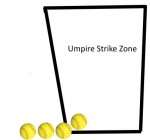When your DD is pitching, she has to think about the situation and the count and where to put the ball. Even if your DD is not calling the game herself, she has to ***THINK***. (I know it really, really hurts teenage girls to think.)
A coach might call the pitch or the pitch and location. The pitcher has to "fill in the blanks".
The picture illustrates a simple situation. The coach has called for a low outside fastball. Now, the pitcher has to decide what "low and outside" means.
1) The picture shows the *UMPIRE'S* strike zone. The perfectly rectangular strike zone described in the rule book DOES NOT EXIST IN SOFTBALL. In professional baseball, umpires are paid between $1000 to $2000 for each game. They have something very close to the perfect rectangular strike zone. Your DD's umpire is lucky to get $75 a game--so, your DD is going to get a $75.00 strike zone.
Your DD has to learn the umpire's strike zone. I'm very serious about this next statement: If your DD rolls her eyes or has a "mini-temper tantrum" because of an umpire's call, you should do everything you can to make sure she does not do it again. When your DD steps on the rubber, she has forfeited the right to be emotional. Every call the umpire makes is simply information about the strike zone.
Mini-temper tantrums are the death of a pitcher at anything over 14U ball--the umpires hate them. The other teams get inspired because they think the pitcher is cracking. If you as a parent even slightly condone this behavior, your DD will never be good.
2) The location of the pitch is thought of in terms of "balls" from the called location. A softball is roughly 4 inches in diameter. So, a low outside fastball exactly at the corner of the zone is "zero balls" from the location. A ball slightly off the plate is "one ball" (4 inches) off the plate" A ball considered "very far outside" is two balls (8 inches) off the plate.
3) You'll notice one ball which is located completely within the strike zone. This pitch is one ball over the plate.
Here is pitching an at bat early in the game. Assume that the coach is calling only low outside fastballs. (Yes, I know no one should ever call 5 low outside fastballs in a row.)
Count 0-0 Pitch 1: One ball over the plate. "I need a first pitch strike"
Count 0-1 Pitch 2: Zero balls over the plate. "I'm willing bet my control is better than the batter's control."
Count 0-2 Pitch 3: Two balls off the plate "Maybe I get the batter to go fishing."
Count 1-2 Pitch 4: One ball off the plate. "Perhaps something a little closer might work."
Count 2-2 Pitch 5: Zero balls over the plate. "Ok...it is me vs. her. I'm a better pitcher than she is a batter."

A coach might call the pitch or the pitch and location. The pitcher has to "fill in the blanks".
The picture illustrates a simple situation. The coach has called for a low outside fastball. Now, the pitcher has to decide what "low and outside" means.
1) The picture shows the *UMPIRE'S* strike zone. The perfectly rectangular strike zone described in the rule book DOES NOT EXIST IN SOFTBALL. In professional baseball, umpires are paid between $1000 to $2000 for each game. They have something very close to the perfect rectangular strike zone. Your DD's umpire is lucky to get $75 a game--so, your DD is going to get a $75.00 strike zone.
Your DD has to learn the umpire's strike zone. I'm very serious about this next statement: If your DD rolls her eyes or has a "mini-temper tantrum" because of an umpire's call, you should do everything you can to make sure she does not do it again. When your DD steps on the rubber, she has forfeited the right to be emotional. Every call the umpire makes is simply information about the strike zone.
Mini-temper tantrums are the death of a pitcher at anything over 14U ball--the umpires hate them. The other teams get inspired because they think the pitcher is cracking. If you as a parent even slightly condone this behavior, your DD will never be good.
2) The location of the pitch is thought of in terms of "balls" from the called location. A softball is roughly 4 inches in diameter. So, a low outside fastball exactly at the corner of the zone is "zero balls" from the location. A ball slightly off the plate is "one ball" (4 inches) off the plate" A ball considered "very far outside" is two balls (8 inches) off the plate.
3) You'll notice one ball which is located completely within the strike zone. This pitch is one ball over the plate.
Here is pitching an at bat early in the game. Assume that the coach is calling only low outside fastballs. (Yes, I know no one should ever call 5 low outside fastballs in a row.)
Count 0-0 Pitch 1: One ball over the plate. "I need a first pitch strike"
Count 0-1 Pitch 2: Zero balls over the plate. "I'm willing bet my control is better than the batter's control."
Count 0-2 Pitch 3: Two balls off the plate "Maybe I get the batter to go fishing."
Count 1-2 Pitch 4: One ball off the plate. "Perhaps something a little closer might work."
Count 2-2 Pitch 5: Zero balls over the plate. "Ok...it is me vs. her. I'm a better pitcher than she is a batter."

Last edited:



